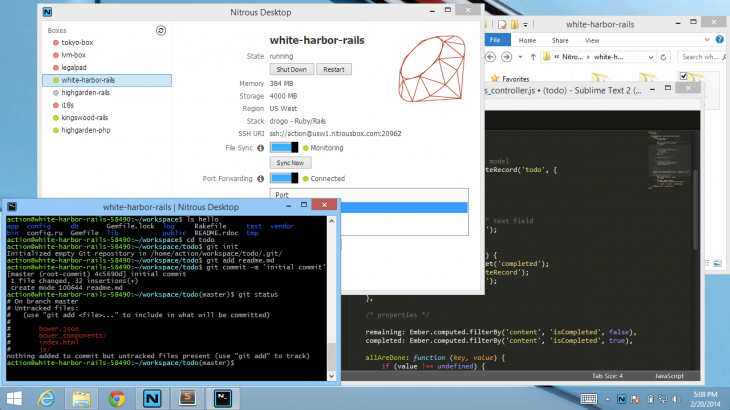
Nitrous.IO, a 500 Startups-backed backend development platform, is setting out on a mission to save software developers time by cutting out the repetitive parts of creating development environments and automating them.
To this extent, Nitrous.IO announced that it has closed a $6.65 million Series A round led by Bessemer Venture Partners and with investors including 500 Startups, Facebook co-founder Eduardo Saverin, and Golden Gate Ventures.
The company lets developers who build Web applications using Ruby, Node.js, Python, and Go programming languages take advantage of its platform to create a testing environment. Nitrous.IO co-founder Arun Thampi explains that building an environment takes time — it takes almost half a day for a really experienced programmer to get a machine up to speed before he can start coding, while for less expert ones, it takes a few days.
For example, he tells us that at LinkedIn it takes an average of three days for a new engineer to set up a development environment just to get started on coding, because the company has a “super complex development stack.” Nitrous.IO has the ability to take away all these three days — developers just start coding within the environment.
“This happens for all kinds of developers — it happens within engineering teams, so if a new engineer joins a new company, it takes on average a couple of days to get set up. This is the kind of thing we experienced ourselves and we wanted to kind of fix that,” he tells TNW.

Sandeep Chivukula, who is in charge of business development at Nitrous.IO, says:
We are taking the tools that people already know how to use, and we’re taking the repetitive and boring parts and automating them. Nobody wants to set up the language over and over again just because they have a new project. Any engineer and organization wants to finish their project and ship that code, right?
It’s a very nice fit with what enterprises are trying to do, which is deliver products for their customers. We take out all of the boring pieces so you can focus on what matters to you.
The next step that Nitrous.IO is taking is therefore to target enterprises.
“We think this is obviously going to be a huge movement, both for organizations and businesses who are trying to get their engineers to be more productive,” Nitrous.IO co-founder and CEO AJ Solimine says.
Over 100,000 developers have signed up for Nitrous.IO since the launch of its public beta seven months ago, marking 50 percent year-on-year growth. The company says it has helped developers save over 500,000 hours of setup and configuration time, or over $37.5 Million to date.
Solimine tells TNW this is a “huge signal” that developers are taking their service positively, as the company hasn’t spent a dollar on marketing and its traction is all via word-of-mouth. Nitrous.IO is therefore going to use most of its latest funding to hire more engineers and expand the business.
“We want to be very aggressive. We are very confident that the majority of application development is going to be performed in this way, in the cloud and leveraging cloud infrastructure, and we think this is going to happen in the next three to five years. It’s really riding off the initial traction that we’ve had,” he says.
Other than catering to enterprises, Nitrous.IO takes its role in programming education very seriously. Thampi says: “Learning to code is fine, but setting up the development environment is almost always the first step and the most difficult step that a person learning to code experiences, and we take away that problem completely.”
Nitrous.IO is thus a key part of the ‘Learn to Code’ movement, used in classes by Rails Girls and General Assembly among others, as well as public and private schools in the US and internationally. Solimine says:
What Nitrous.io really provides is this accessibility. We kind of level the playing field in a sense — we reduce those barriers.
New programmers are hitting this friction point: ‘Oh I don’t really understand how to set this up, or I don’t understand how to configure this database to work with Ruby.’ We basically make that a million times easier.
The other part of it is that Nitrous.IO essentially removes the barrier of students having to own a $2,000 machine, given that developers are working on cloud infrastructure instead of a local workstation. This is especially prominent in the Chromebook movement, since Nitrous.IO can basically turn Chrome OS-powered devices into powerful hardware platforms for developers. Chivukula says:
The thing that excites us about the education space is that today, a lot of people are teaching children and adults how to code, but at the end of the day, you still have to have that $2,000 machine.
But with Nitrous.io, you don’t. We have a free tier that’s available all the time, and we’re really proud to be part of that movement where you can write your code, the library closes for the day, close your browser, come back to the library tomorrow, fire it up then start working on your code again.
Nitrous.IO is a company that is possible only now due to the development of what it calls “bleeding-edge technology.” By taking away a tedious task that made seasoned developers slower at their jobs, as well as removing the barriers for beginner developers, it is well-positioned to bring much-needed improvements to an industry that’s moving faster than ever.
Don’t miss: Appmethod: a new platform for creating “truly native” apps for Android, iOS, Windows and OS X
Headline image via Shutterstock
Get the TNW newsletter
Get the most important tech news in your inbox each week.






